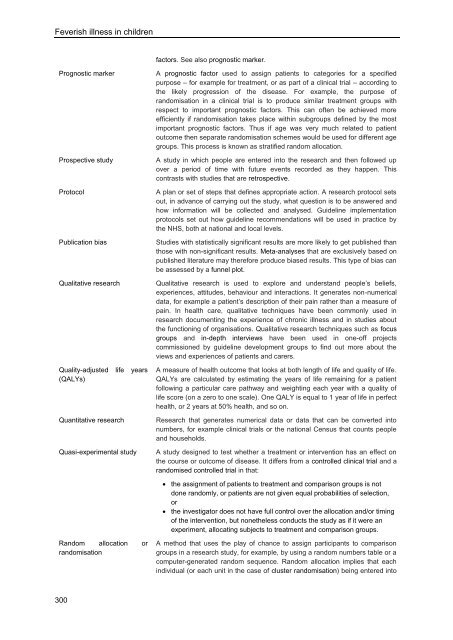A5V4d
A5V4d
A5V4d
You also want an ePaper? Increase the reach of your titles
YUMPU automatically turns print PDFs into web optimized ePapers that Google loves.
Feverish illness in children<br />
300<br />
factors. See also prognostic marker.<br />
Prognostic marker A prognostic factor used to assign patients to categories for a specified<br />
purpose – for example for treatment, or as part of a clinical trial – according to<br />
the likely progression of the disease. For example, the purpose of<br />
randomisation in a clinical trial is to produce similar treatment groups with<br />
respect to important prognostic factors. This can often be achieved more<br />
efficiently if randomisation takes place within subgroups defined by the most<br />
important prognostic factors. Thus if age was very much related to patient<br />
outcome then separate randomisation schemes would be used for different age<br />
groups. This process is known as stratified random allocation.<br />
Prospective study A study in which people are entered into the research and then followed up<br />
over a period of time with future events recorded as they happen. This<br />
contrasts with studies that are retrospective.<br />
Protocol A plan or set of steps that defines appropriate action. A research protocol sets<br />
out, in advance of carrying out the study, what question is to be answered and<br />
how information will be collected and analysed. Guideline implementation<br />
protocols set out how guideline recommendations will be used in practice by<br />
the NHS, both at national and local levels.<br />
Publication bias Studies with statistically significant results are more likely to get published than<br />
those with non-significant results. Meta-analyses that are exclusively based on<br />
published literature may therefore produce biased results. This type of bias can<br />
be assessed by a funnel plot.<br />
Qualitative research Qualitative research is used to explore and understand people’s beliefs,<br />
experiences, attitudes, behaviour and interactions. It generates non-numerical<br />
data, for example a patient’s description of their pain rather than a measure of<br />
pain. In health care, qualitative techniques have been commonly used in<br />
research documenting the experience of chronic illness and in studies about<br />
the functioning of organisations. Qualitative research techniques such as focus<br />
groups and in-depth interviews have been used in one-off projects<br />
commissioned by guideline development groups to find out more about the<br />
views and experiences of patients and carers.<br />
Quality-adjusted life years<br />
(QALYs)<br />
A measure of health outcome that looks at both length of life and quality of life.<br />
QALYs are calculated by estimating the years of life remaining for a patient<br />
following a particular care pathway and weighting each year with a quality of<br />
life score (on a zero to one scale). One QALY is equal to 1 year of life in perfect<br />
health, or 2 years at 50% health, and so on.<br />
Quantitative research Research that generates numerical data or data that can be converted into<br />
numbers, for example clinical trials or the national Census that counts people<br />
and households.<br />
Quasi-experimental study A study designed to test whether a treatment or intervention has an effect on<br />
the course or outcome of disease. It differs from a controlled clinical trial and a<br />
randomised controlled trial in that:<br />
Random allocation or<br />
randomisation<br />
the assignment of patients to treatment and comparison groups is not<br />
done randomly, or patients are not given equal probabilities of selection,<br />
or<br />
the investigator does not have full control over the allocation and/or timing<br />
of the intervention, but nonetheless conducts the study as if it were an<br />
experiment, allocating subjects to treatment and comparison groups.<br />
A method that uses the play of chance to assign participants to comparison<br />
groups in a research study, for example, by using a random numbers table or a<br />
computer-generated random sequence. Random allocation implies that each<br />
individual (or each unit in the case of cluster randomisation) being entered into


